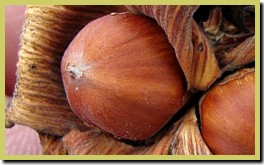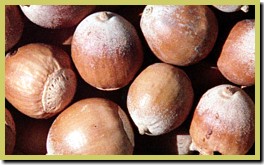
NUTS!
Wild FoodThere was a time when people were dependent on what they could find in nature for their food. Before civilization and agriculture, people lived as hunters and gatherers. The men had big parties when they finally killed something, but the women usually fed the tribe on a day to day basis by gathering plants as food. Harvesting wild foods can put us back in touch with nature and it can provide quite a treat, too. Most of us are familiar with the various berries available to pick in the country or at our cottages, but did you know that we have wild nuts available in Manitoba, too? Three local plants produce large and edible nuts: the Bur Oak (Quercus macrocarpa), American Hazel (Corylus americana) and Beaked Hazel (Corylus cornuta). The Bur Oak is a very common tree in southern Manitoba and most people are aware of the sometimes prolific acorn crop these trees produce, but few are aware that acorns are edible. |
||
Hazel Nuts (Filberts!)
Hazel nuts can be eaten raw, or roasted in the oven, at 180 C for 30 min., with oil and salt to taste. Dry roasted hazel nuts can be ground into a powder to thicken sauces or mixed with flour in baking. Getting enough hazel nuts to make it worthwhile, however, can be a task. Be on the look out for them in late August. They will be ripe by then and won’t last on the bushes for long. Squirrels love hazel nuts and will cut them off the bushes, sometimes before they ripen, to store away for winter. Unless there is a very heavy crop of nuts on the bushes, there usually won’t be enough for people to share in the harvest. And when you collect some, you still have to shell them, too. Yes, wild food means work! |
||
|
||
Might Oaks Grow from These!
Acorns are often so plentiful they become a nuisance, but in some years they may be almost absent. It’s natural for the production of acorns to vary greatly from year to year. By overproducing acorns in some years and producing little in others, the trees are ensuring that populations of nut-eaters, like squirrels, can’t grow to where they eat all the acorns every year. In years when acorns are superabundant, not only can’t the squirrels eat all the nuts, but they help the trees by caching nuts, burying them in the ground; in effect planting them and ensuring some reproductive success for the oaks. You can even grow your own oak tree or hazel bush from the nuts you collect. To get them to germinate, store the nuts in damp soil or peat in your fridge for the winter, then plant them in the spring. Or you can bury them right away in the fall where you’d like them to grow and cover the spot with squirrel-proof wire until the seedlings emerge in the spring. In ClosingA great book to help you with your wild foraging, and preparing what you collect, is Edible Wild Fruits and Nuts of Canada, by N. Turner and A. Szczawinski. So, try some wild foods other than berries. “Go nuts”. |
||
|
| You can help NatureNorth produce more great articles with a secure donation through PayPal. Our Google Adsense ads pay our server costs, but that's about it. To learn more follow this link: Support NatureNorth. Thank-you! | |


